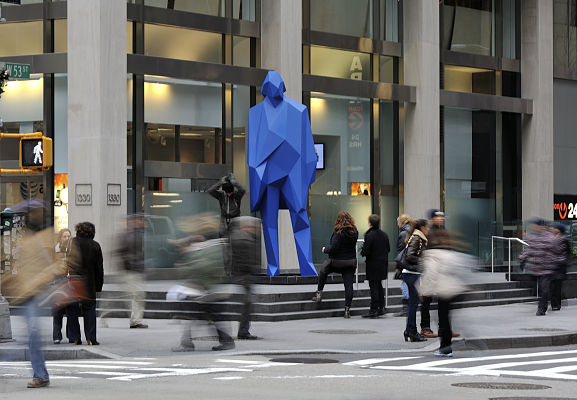
French artist Xavier Veilhan sometimes draws comparisons to Jeff Koons for his brightly colored, radically simplified sculptures -- though without the kitsch and self-aggrandizement. Both deal with monumentality and both locate their imagery within a type of popular, or collective imagination. The two are also among the elite group of contemporary artists who have been invited to exhibit at the Chateau de Versailles.
Veilhan, whose work also includes painting, photography, performance and filmmaking, often experiments with technology to reveal different aspects of perception. A 3D scanner used to make sculptural portraits of friends and colleagues is a favorite tool of his investigation, and was the starting point for his new permanent installation in midtown Manhattan, at the corner of 53rd St. and Sixth Avenue.
"Jean-Marc," the blue, steel, multi-faceted giant, commissioned by RXR Realty -- whose offices occupy the block -- is the portrait of fellow French artist, Jean-Marc Bustamante. Though angled and futuristic, the frozen geometries of the drapery and contrapposto stance nonetheless look part Balzac, part David -- a profile that seems as timeless as it does classical in this new iteration.

"Jean-Marc, 2012" ; Courtesy Andréhn-Schiptjenko, Stockholm. Photo © Stephen Smith ; © Veilhan / ADAGP, Paris, 2012 & Ars, New York, 2012
CD: You just installed a new sculpture on the corner of 53rd and 6th Ave. How did you approach the site?
XV: My idea of sculpture is that it should be dynamic and beautiful--as much as it can be--and that you locate yourself with it, like the LOVE sign a few blocks up on 56th St. There are a few statues--or rather visual events--that you associate with places that are otherwise quite interchangeable in New York.
So it's a marker. Plus it's a link between the architecture of the city and the people passing by. It's a human representation but as a still, oversize element it is also connected to the buildings. So that's extremely basic. My ambition is not to make something conceptually complicated; it's really to make more of a driving kind of sculpture. It's fine for me that you pass by sitting in a taxi almost sleeping and that you see it. It should work this way.
I've read that speed is an important element for you. Does this idea of a drive-by viewing relate to an idea of the modern attention span?
Well, it depends. If you consider those things as "seen with speed," it obviously links it to an idea of superficiality. But on another hand, it's also more like a ballistic thing -- that it gives you a strong impact because it hits you at a certain speed. Everything is in constant motion on that corner. I wanted to establish a system of vision that is coherent with the rest of what people are looking at -- or the rest of their experience. I don't want them to slow down to get access to the meaning of the art.
Was the choice of it being Jean-Marc Bustamante significant?
Well, I love Jean-Marc. He's one of my friends. And there are very few artists that I can talk very sincerely about art with. And I have always liked his allure. He has a regal posture and I'm trying to create a situation where people can -- just by body language -- express what they are and who they are. I think Jean-Marc is very good at it.
You started out with a 3D scan of him that mapped out hundreds of thousands of points, and then you reduce those dramatically until you arrive at just the most essential ones.
Yes, the scan technique is a way to let people get into their sculpture and occupy the space without my doing much. I'm interested in leaving space for the model to express himself without having a kind of psychological projection from the artist. But it's also linked directly to something we have in our brains -- that we catch a silhouette, and that we can identify it.
Right. As I was thinking about this I started thinking about pointillism. In a way your method translates the idea that the eye will fill in the gaps between colors to create more vibrant colors -- that with less information we actually fill in the rest.
Yes. It's actually a very good comparison because visually [the statue] is very full and in your face -- it has a certain violence because it's big and has a brutal shape -- but to me it's also like a kind of blank projection space for whatever people want to bring in.
It's funny because my gallerist from Sweden, Cilène Andréhn, who only ever talked with Jean-Marc by email, arrived at JFK and was queuing at customs and actually recognized him ahead of her... So it's funny because it's difficult to imagine that you can recognize somebody from their posture alone...and from such a simplified statue.
It's an investigation into the amount of information we actually retain and use to build our memories of things.
I'm playing with images that people already know -- a frontal figure, or a statue -- it's something that's already in their brains before they see it. Most people think that art is proposing a new vision. I don't think that at all. I try to match to something that already exists but with different means and with a different angle maybe.
Is there an ideal experience for you of recognizing things that you're looking for?
Well any great idea. Something like this feeling of, "How is it possible that we haven't thought of this before! It's so obvious!"
I'm not using language directly in my art but I'm trying to establish a link with the people looking at this -- to find a very simple or universal language, which is actually a total illusion because nothing is fully universal -- but that people would think that what leads them to the shapes I'm proposing is not something that has been taught to them but something almost natural, which is once again, an illusion.
Your work looks incredibly modern or futuristic, and yet I know that for you technology is also something that dates things.
Sure, that's one of the reasons why I use it because I like some things to be very of that time, very dated. And actually there is no real link to the future. I only want to be right now, not to be postmodern but to be modern in terms of being linked to the future and to the past just by trying to do something connected as much as possible with the environment, with the non-art.
I saw Rudy Burckhardt's films of New York recently. They were shot in the 40s and 50s and I kept thinking that the scale of the city seemed so much more human then. How big is Jean-Marc? He's about double a man's size?
A little bit more. I always talk about volume, not about sizes because this is probably 12 times the volume of Jean-Marc. In a city like New York, with the size of the buildings, you disappear if you make it the size of a man. The statue's volume is between the people and the building.
In a way he's almost the right size for New York now. Like it's a city made for people who are actually this big.
New York is very special. It's what I dreamed about when I was a teenager. Like, this is life. Here everything is constantly going, it's all-we-can-eat always and it's too much. But to visit for four days, five days, eight days -- New York is perfect; a great city. And also I really feel like -- this place, 53rd and 6th -- it's the center of the capital of the world. I'm very honored to build it there.
To see more from Xavier Veilhan: www.veilhan.net